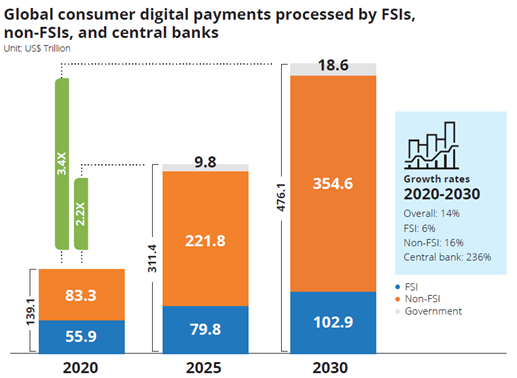
By 2030, 74% of consumer payments will be handled by non-traditional financial service providers
Austin, TX, U.S., Thursday 27th January 2022 – According to a new study by IDC Financial Insights commissioned by Episode Six, a payments technology company, 74% of consumer payments will be handled by non-traditional financial service institutions (FSIs) by 2030[i]. This figure is an increase from 60% in 2020, putting added pressure on incumbents such as banks, insurers and credit unions. The IDC InfoBrief, Future Ready Payments Technology Reshapes the Playing Field for the Industry, highlights that while the payments world is changing FSI paytech is not, pushing lucrative consumer payment volumes to non-FSIs.
Factors driving this change include a rise in new (or emerging) digital asset classes, real time payments and new point of sale payment options such as Buy Now Pay Later (BNPL):
The payments landscape is changing at pace, but the IDC InfoBrief finds that 73% of FSIs globally currently have paytech infrastructures that are not well equipped to handle payments for 2023 and beyond. IDC deemed only 3% of FSIs to have ‘future ready’ paytech – meaning payments infrastructure that enables payments anywhere and everywhere for any possible present and future asset class. Future ready paytech also gives FSIs the ability to configure and reconfigure payment products to stay ahead of new entrant competition and consumer demands. And while IDC predicts that global FSI spending on paytech will double to US$80.3 billion in 2030 (from US$39.7 billion in 2020), FSIs are not investing enough in the infrastructure that enables them to compete with non-FSIs. Failing to adapt to future ready paytech will cost the FSI industry US$250 billion in payments revenue.
“The world of consumer payments is rapidly evolving; from the way we make them to the companies that handle them,” said Michael Yeo, Associate Research Director at IDC Financial Insights. “What this change presents is both a challenge and opportunity for incumbent FSIs. Despite the trends which are unfolding, FSIs can fight their displacement from consumer payments by reshaping the role that they fulfil in the payments landscape of tomorrow. To achieve this, their focus and spending must be on future ready paytech solutions – otherwise they risk continuously playing catch up with digitally native non-FSIs”.
“Traditional financial services institutions will continue to lose consumer payments market share, and corresponding revenue, until they have infrastructure that is able to support new ways to pay” added John Mitchell, CEO of Episode Six. “Competition in payments is increasing. There is a land grab taking place for the hearts, minds and wallets of consumers the world over. FSIs need to be able to process value in whatever form consumers demand – fiat, crypto and gaming currencies, loyalty points and value denominations that don’t exist today. That requires paytech infrastructure that’s fast to deploy, highly configurable and future ready. IDC’s data shows that FSIs are investing, but also suggests that they’re focusing on maintaining a quickly diminishing position, rather than ensuring an ability to compete in the future.”
The IDC InfoBrief commissioned by Episode Six ‘Future Ready Payments Technology Reshapes the Playing Field for the Industry: Driving Over 70% of Payments to Shift to Non-FSIs by 2030, can be downloaded free of charge here.
The Payments Association
St Clement’s House
27 Clements Lane
London EC4N 7AE
© Copyright 2024 The Payments Association. All Rights Reserved. The Payments Association is the trading name of Emerging Payments Ventures Limited.
Emerging Ventures Limited t/a The Payments Association; Registered in England and Wales, Company Number 06672728; VAT no. 938829859; Registered office address St. Clement’s House, 27 Clements Lane, London, England, EC4N 7AE.







Log in to access complimentary passes or discounts and access exclusive content as part of your membership. An auto-login link will be sent directly to your email.
We use an auto-login link to ensure optimum security for your members hub. Simply enter your professional work e-mail address into the input area and you’ll receive a link to directly access your account.
Instead of using passwords, we e-mail you a link to log in to the site. This allows us to automatically verify you and apply member benefits based on your e-mail domain name.
Please click the button below which relates to the issue you’re having.
Sometimes our e-mails end up in spam. Make sure to check your spam folder for e-mails from The Payments Association
Most modern e-mail clients now separate e-mails into different tabs. For example, Outlook has an “Other” tab, and Gmail has tabs for different types of e-mails, such as promotional.
For security reasons the link will expire after 60 minutes. Try submitting the login form again and wait a few seconds for the e-mail to arrive.
The link will only work one time – once it’s been clicked, the link won’t log you in again. Instead, you’ll need to go back to the login screen and generate a new link.
Make sure you’re clicking the link on the most recent e-mail that’s been sent to you. We recommend deleting the e-mail once you’ve clicked the link.
Some security systems will automatically click on links in e-mails to check for phishing, malware, viruses and other malicious threats. If these have been clicked, it won’t work when you try to click on the link.
For security reasons, e-mail address changes can only be complete by your Member Engagement Manager. Please contact the team directly for further help.